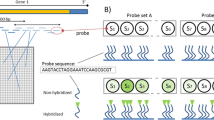Abstract
A wide variety of software tools are available to analyze microarray data. To identify the optimum software for any project, it is essential to define specific and essential criteria on which to evaluate the advantages of the key features. In this review we describe the results of our comparison of several software tools. We then conclude with a discussion of the subset of tools that are most commonly used and describe the features that would constitute the “ideal microarray analysis software suite.”
Similar content being viewed by others
References
Beaucage, S. L. (2001) Strategies in the preparation of DNA oligonucleotide arrays for diagnostic applications. Curr. Med. Chem. 8, 1213–1244.
Al-Khaldi, S. F., Martin, S. A., Rasooly, A., and Evans, J. D. (2002) DNA microarray technology used for studying foodborne pathogens and microbial habitats: minireview. J. AOAC Int. 85, 906–910.
Marton, M. J., DeRisi, J. L., Bennett, H. A., et al. (1998) Drug target validation and identification of secondary drug target effects using DNA microarrays. Nature Med. 4, 1293–1301.
Draghici, S. (2003) Data analysis and visualization in DNA microarrays. In Introduction to Bioinformatics (Krawetz, S. and Womble, D., eds.). Humana Press, Totowa, NJ, pp. 665–692.
Bittner, M., Meltzer, Y., Chen, Y., et al. (2000) Molecular classification of cutaneous malignant melanoma by gene expression profiling. Nature 406, 536–540.
Eisen, M. B. and Brown, P. O. (1999) DNA arrays for analysis of gene expression. Methods Enzymol. 303, 179–205.
Hegde, P., Qi, R., Abernathy, K., et al. (2000) A concise guide to cDNA microarray analysis. Biotechniques 29, 548–556.
Gentleman, R. and Carey, V. (2002) Bioconductor. R News 2, 11–16.
Saal, L., Troein, C., Vallon-Christersson, J., Gruvberger, S., Borg, A., and Peterson, C. (2002) BioArray Software Environment (BASE): a platform for comprehensive management and analysis of microarray data. Genome Biol. 3, software0003.1–0003.6.
Wildsmith, S. E. and Elcock, F. J. (2001) Microarrays under the microscope. Mol. Pathol. 54, 8–16.
Spellman, P. T., Miller, M., Stewart, J., et al. (2002) Design and implementation of microarray gene expression markup language (MAGE-ML). Genome Biol. 3, RESEARCH0046.
Diehn, M., Sherlock, G., Binkley G., et al. (2003) SOURCE: a unified genomic resource of functional annotations, ontologies, and gene expression data. Nucleic Acids Res. 31, 219–223.
Khatri, P., Draghici, S., Ostermeier, C., and Krawetz, S. (2002) Profiling gene expression using Onto-Express. Genomics 79, 266–270.
Author information
Authors and Affiliations
Corresponding author
Rights and permissions
About this article
Cite this article
Liu, D.K., Yao, B., Fayz, B. et al. Comparative evaluation of microarray analysis software. Mol Biotechnol 26, 225–232 (2004). https://doi.org/10.1385/MB:26:3:225
Issue Date:
DOI: https://doi.org/10.1385/MB:26:3:225



